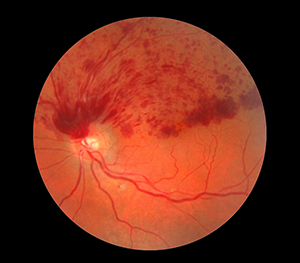Ocular Ischemic Syndrome

What is Ocular Ischemic Syndrome (OIS)?
Ocular ischemic syndrome (OIS) is a rare condition characterized by abnormal growth of blood vessels in the eye causing vision loss and pain. It occurs due to ocular hypoperfusion (a condition where the blood supply to tissues is restricted, resulting in a lack of oxygen and glucose required for metabolism, also called ischemia). OIS is a severe form of chronic ischemia affecting both anterior (front, a one-third portion of the eye) and posterior (back, a two-third portion of the eye) segments and also the orbital structures of the eye. OIS occurs due to carotid artery stenosis i.e., when the blood vessels that supply blood to the eye become narrowed (>90%). Atherosclerosis (thickening of artery walls due to accumulation of calcium and cholesterol) is a major cause of OIS. The other causes of OIS are giant cell arteritis, fibrovascular dysplasia, Takayasu arteritis, Behcet's disease and dissecting aneurysm of the carotid artery.
OIS is more commonly seen in males than in females and occurs in the age group of 50-80 years. The untreated condition of the ocular ischemic syndrome can lead to visual loss.
Symptoms of Ocular Ischemic Syndrome(OIS)
The common symptoms of OIS include:
- Vision loss
- Eye pain
Other clinical manifestations include:
- Uveitis (inflammation of the uvea)
- Neovascularization
- Asymmetric cataract
- Sluggish reaction to light
- Corneal oedema
- Dilated retinal veins
- Cherry-red spot
- Narrowed retinal arteries
- Orbital pain
- Cotton-wool spots
- Vitreous haemorrhage
Diagnosis of Ocular Ischemic Syndrome(OIS)
OIS can be diagnosed by carotid artery ultrasound, Doppler imaging, and fundus fluorescein angiogram. The differential diagnosis includes diabetic retinopathy and advanced central retinal vein occlusion.
Treatment for Ocular Ischemic Syndrome(OIS)
The management of OIS involves treatment advice from doctors of various fields like an ophthalmologist, a neurologist, and a vascular surgeon. A consultation with a cardiologist may also be necessary in some cases. The treatment can be localized to the eye or systemic to address the narrowed carotid arteries. Local treatment includes medications, surgery or laser treatments to the eye. The systemic treatments include medications and surgical treatment to open up the carotid arteries. Early diagnosis is very essential with respect to treatment and survival due to the risk of stroke from carotid artery narrowing.
Related Topics:
- Uveitis and Ocular Inflammation
- Dry Eyes
- Lid Cysts
- Blepharitis
- Glaucoma
- Retinal Tear
- Cataract
- Diabetic Macular Oedema
- Retinal Vein Occlusion
- Macular Oedema
- Cystoid Macular Oedema
- Central Serous Retinopathy
- Vision Disorders
- Watery Eye
- Tear Duct Obstruction
- Vein Occlusion
- Chalazion
- Vein Occlusion Macular Oedema
- Allergic Disorders of the Eye
- Blurred Vision
- Distortion of Central Vision
- Ocular Ischemic Syndrome
- Optic Neuropathy
- Posterior Uveitis
- Proliferative Diabetic Retinopathy
- Temporal Arteritis
- WET AMD
- Traumatic Iritis
- Acute/ Chronic/Recurrent Iridocyclitis
- Am I at Risk of Glaucoma?
- Epiretinal Membrane
- Open and Closed Iridocorneal Angles
- Pars Planitis/Intermediate Uveitis
- Retinal Detachment
- Subconjunctival Haemorrhage












